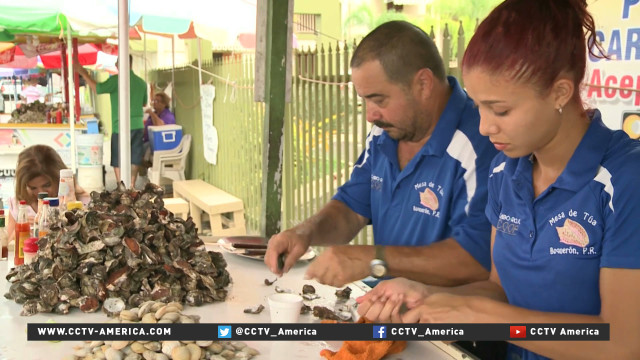SAN JUAN — This fall’s hurricane season has been rough on Jesús Vázquez’s family business outside the capital of Puerto Rico.
Their 35-year-old ice factory and adjacent laundromat hasn’t had power since Hurricane Irma, which hit Puerto Rico on Sept. 6, thirteen days before Hurricane Maria devastated the island.
And the family’s rental property business is losing roughly $35,000 a month, because it’s not charging rent to tenants who lack power, lost their jobs, or can’t reopen their own businesses.
Vázquez says he’s spending three times as much on diesel generators as he did on electricity from the island’s bankrupt power utility, the Puerto Rico Electric Power Authority (PREPA).
Most of his clients are small—convenience stores, restaurants, bars—and many haven’t reopened.
“The ideal word to describe the overall situation is ‘catastrophic,’ ” Vázquez says. More than two months since Maria, “you realize things are not improving, particularly for small businesses.”
Delays in restoring and running power consistently—Prepa’s generation capacity is only around 68 percent—are undermining Puerto Rico’s entrepreneurs. Business conditions have been bad for years, a result of a decade-long recession, which spurred significant migration away from the island.
As many as 470,000 Puerto Ricans may move to the mainland through 2019, according to a report by the Center for Puerto Rican Studies at Hunter College in New York, because of Maria’s destruction. In early December a federal judge canceled plans to bring Puerto Rico’s $74 billion bankruptcy case back to the island because of hotel closures.
Nelson Ramírez, president of the Centro Unido de Detallistas (CUD), a small-business advocacy group in San Juan, estimates two-thirds of the island’s roughly 45,000 small and midsize businesses have closed temporarily. “Our conservative estimate was 5,000 businesses wouldn’t ever reopen,” Ramírez says. “But it could easily reach 10,000.” Permanent closures could hit 40 percent, says Arnaldo Cruz, director of research and analytics at the nonprofit Foundation for Puerto Rico. “The Puerto Rico government has very bad economic data, even before Maria, so we won’t get accurate official reports for a while,” he says.
Small and midsize businesses represent 90 percent of private companies on the island and about one-third of the workforce, according to data released last year by the commonwealth government’s Puerto Rico Trade and Export Co. The fallout from this year’s hurricanes is already apparent: U.S. Department of Labor figures show employers cut payrolls the most in 21 years in October and unemployment claims surged to an 11-year high in November.
“Business owners say the situation is dire,” says Ramírez. “When they close and lay off their workers, it becomes a vicious cycle, because those people don’t buy things, the economy weakens, and people leave the island.”
Carla López de Azúa, who rents spaces to artisans and restaurateurs in her 8,000-square-foot market in San Juan’s Santurce area, is committed to the island’s recovery, even though half her tenants left after the power failed and economic indicators turned grim. Supermarket prices, for example, have “skyrocketed,” she says. “I know people who don’t know what they are going to feed their kids.”
Since her power returned in late November, she’s been trying to lure back tenants who shut their businesses. Puerto Rico’s economic difficulty isn’t new, López de Azúa says. Many of her renters lost their jobs during the most recent recession and reinvented themselves as entrepreneurs. After Maria, some left for the U.S. mainland. “It’s important for them to know they can come back and make a living,” she says.
Restoring, then improving, the power grid is priority No. 1 for the island’s recovery. “Infrastructure has to work,” says Cruz of the Foundation for Puerto Rico, noting that a lot of the island still has no consistent power. Once businesses are back on the grid, you will see “economic recovery really, really accelerate,” says Rob Glenn, the Federal Emergency Management Agency’s private-sector division director.
The Small Business Administration is offering low-interest business loans of up to $2 million to owners in Puerto Rico affected by Maria. Of the 3,533 applications received as of Dec. 5, the agency has approved only 50 loans totaling $6.2 million. “This is the early phase of the small business recovery,” agency spokeswoman Carol Chastang wrote in an email. “Loan approvals will increase in the coming days.” She notes the deadline has been extended to March 20. Cruz says many Puerto Rican entrepreneurs won’t apply for the loans if they’re not sure they’ll have enough clients to keep their businesses running.
Some, like Ignacio Pino, who runs biotech startup CDI Laboratories Inc. in an industrial park in Mayaguez, are cautiously optimistic. Even though CDI has lost about $400,000 since Maria, the business is in a better position than most because it doesn’t depend on local customers. It ships its proteins to hospital research labs and other clients on the mainland.
“It’s going to be hell, but I think we’ll make it,” Pino says. As a Plan B, his team is scouting locations in the states that lure biotech companies with incentives. He’s trying to raise expansion capital but worries investors won’t want to risk their money on a small company in Puerto Rico.
Betting a small cash infusion can help, the Foundation for Puerto Rico has raised almost $600,000 to give in $5,000 allotments to entrepreneurs in commercial districts it’s trying to revive, says Cruz. The Puerto Rico Trade and Export Co. in mid-November started a $200,000 program awarding grants of up to $1,000 to businesses affected by the hurricanes. Executive Director Ricardo Llerandi acknowledges the donations available aren’t nearly enough. Many businesses won’t survive, but a year from now, he predicts, new entrepreneurs will have cropped up in their place.
“There’s a spirit of, I’ll create my own job instead of asking someone for a job,”Llerandi says.

